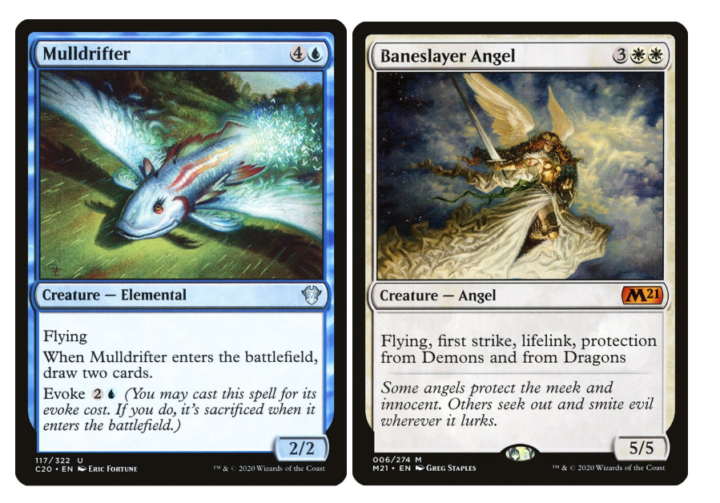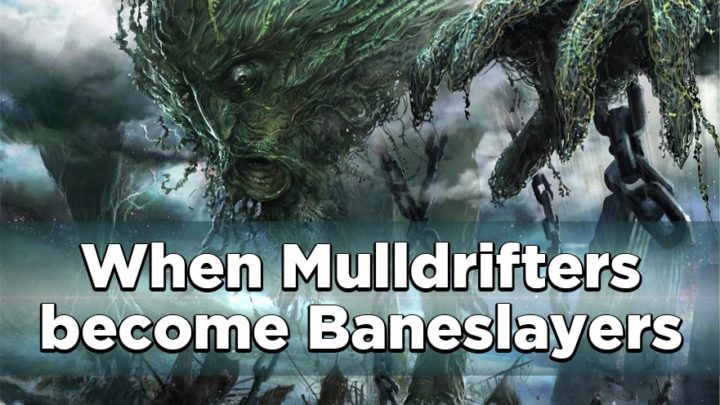Patrick Chapin once said that every creature in your deck should either be a Mulldrifter or a Baneslayer Angel.

Of course, he didn’t mean that literally. Mulldrifter is a classic example of a creature that generates a resource advantage the turn it comes into play. Baneslayer Angel, meanwhile, has high stats for its cost and a generally powerful ability. Each has its strengths and weaknesses — for example, a deck full of Baneslayer Angels is going to be weak in games where keeping up with your opponent on value matters, while Mulldrifters can’t always end the game quickly.
The “Mulldrifters and Baneslayers” dichotomy is fairly balanced, as each has clear counterplay. But what happens when creatures emerge that are both Mulldrifters and Baneslayers?
In M11, we were introduced to the Titans: large creatures that generate a resource advantage the turn they come into play. The Titan cycle didn’t have Baneslayer Angel-quality bodies, but they were close; and, perhaps more importantly, their Mulldrifter-level abilities triggered when they entered the battlefield and when they attacked. At the time, these creatures represented the ceiling of how strong the combination of abilities and combat stats could be on a single card.
But over the last few years of Magic’s history, we’ve seen an increasing number of cards that function a lot like Titans. Flashy and powerful cards get people excited about the game and help sell packs, but balancing these cards can be tricky. I’d like to spend some time tracing the evolution of these creatures and evaluating the effects they’ve had on competitive play — for better or worse.
Tireless Tracker
Tireless Tracker is an excellent example of a creature that provides both card advantage and superior board presence. It’s not surprising that this card saw widespread play throughout its time in Standard, or that it’s popped up in Pioneer and Modern. But Tireless Tracker managed to be powerful without being dominant because it had exploitable weaknesses.
Tracker has two major strengths: it’s reasonably cheap to cast, and it scales throughout the game. As the game goes on, Tracker grows in size and rewards you for drawing lands, which might otherwise be detrimental. However, as a 3/2, Tracker is vulnerable early in the game; you almost never want to run it out on turn three. Tracker can’t hold its own in combat unless you invest time and mana into it, which gives your opponent valuable time to deal with it. Tracker is a solid creature that can provide value and take over combat without being truly explosive.
Siege Rhino
Siege Rhino is one of my personal favorite cards and a centerpiece of a long-standing Standard strategy. A 4/5 with trample for four is probably not good enough for most Standard formats, especially with the prohibitive mana cost attached to Siege Rhino. It may not have the body of a Baneslayer, but its “Mulldrifter” ability — a Lightning Helix that can only hit an opponent — helped make Siege Rhino one of the most widely-played cards in its day.
In Abzan Midrange decks, Siege Rhino served as a bridge between powerful early-game removal and disruption and late-game threats like Tasigur and Elspeth, Sun’s Champion. It could definitely hold its own in combat, beating out a lot of the utility creatures around it, though it wasn’t always the best in the red zone. (Siege Rhinos are known to lock horns with other Siege Rhinos.) But if your opponent killed the Rhino before it entered combat, you still felt like you were up an appreciable amount — which is good, because your opponent probably wants to kill Siege Rhino if they can.
If a creature can be a solid force in combat, and be killed without either player feeling like they lost out tremendously, that’s a hallmark of great creature design.
Cavalier Cycle
In M20, Wizards put a new, more measured spin on the design of the Titan cycle with the Cavaliers. With the exception of Cavalier of Dawn, each of these cards has proven to be powerful and playable in Standard without completely dominating. Even Cavalier of Flame, a major force behind Fires of Invention’s success, simply benefited too much from the “free” activations that Fires facilitated.
The secret to the Cavalier cycle’s success is that they were costed appropriately, but in a way that still allowed them to be powerful and competitive. Five mana may seem cheap given the size of Cavalier of Flame and Cavalier of Thorns, but their mana costs limit your deck-building choices. The Cavaliers also deviated from the Titan formula in that they had two separate abilities that triggered when they entered the battlefield and when they died. Spacing out these effects in this way gives opponents time to breathe instead of forcing them to address a creature that generates advantage every turn.
It’s also worth noting that, around this time, Wizards of the Coast adopted the F.I.R.E. design philosophy. F.I.R.E. (which stands for Fun, Inviting, Replayable, and Exciting) aimed to ramp up power levels and create flashy cards that would have an impact on newer formats. As we saw with Tireless Tracker, Siege Rhino, and the Cavaliers, mana cost played a major role in keeping these cards balanced. But when we see these types of effects at lower or less prohibitive mana costs, creatures can get a lot more powerful.
Hydroid Krasis
Introducing Hydroid Krasis: our first example of a competitive body, a powerful non-combat ability, and a flexible mana cost. Like Tireless Tracker, Hydroid Krasis scales as you progress later into the game. But Krasis’s growth isn’t time-gated after it comes into play; it enters the battlefield as a dominant force on size alone, plus it has two forms of evasion (flying and trample). Siege Rhino was kept in check by its prohibitive multicolor mana cost; Krasis costs a mere XUG. Cavaliers have a strong body and two reasonable abilities, but cost five mana; Krasis can easily outscale them in size and ability.
We’ve seen large Simic creatures with strong effects before, but they never quite made it because of their high mana costs. Hydroid Krasis’s variable mana cost was key to its success, but it’s also spent most of its time in Standard in an environment where excess mana is easy to come by. Nissa, Who Shakes the World and a plethora of ramp spells supercharged Hydroid Krasis, allowing it to be a reasonable mid-game play and a dominating late-game play, all in one.
Uro, Titan of Nature’s Wrath
Uro, Titan of Nature’s Wrath is the current king of the food chain among creatures. It has a Baneslayer-level body and accrues Mulldrifter-level value with a Titan-like triggered ability. But perhaps most importantly, it evades removal and generates an even greater advantage thanks to its escape ability.
I’ve heard plenty of players call Uro a seven-mana 6/6 that draws two cards, puts two lands into play, and gains six life. But there’s an enormous difference between getting all that for seven mana and paying in installments. As a three-mana creature, Uro has an immediate impact early in the game, then comes back for more later. Titans have great stats and powerful abilities, but they cost six mana, and you can deal with them with a single removal spell; Uro refuses to stay dead as long as there’s food in the graveyard for it, which isn’t too much to ask.
Conclusion
There’s been a lot of talk about the power level of Simic creatures of late, and for good reason. Blue excels at accruing card advantage, while green excels at accruing on-board resources like mana and creature power. Put them both together at a low or flexible mana cost, and you end up with a card that’s dialed up to 11.
Mulldrifter’s card advantage accrual is balanced out by its relative weakness in combat. Baneslayer Angel is allowed to dominate combat, but that’s about all. Titans were kept in check because of their high mana costs, yet were still powerful. But with Uro and Hydroid Krasis running around, it’s perhaps not surprising that even Baneslayer itself isn’t powerful enough to see play in current Standard.
Cards like Uro and Hydroid Krasis invalidate a lot of other cards in their environments, and I hope we see more measured designs like Kroxa, Titan of Death’s Hunger in the future. I’d also love to hear from you and get your opinions on this subject. Feel free to reach out to me on Twitter at @RappaciousOne! I’ll see you all next week.

Michael Rapp is a Modern specialist who favors Thoughtseize decks. Magic sates his desire for competition and constant improvement.

